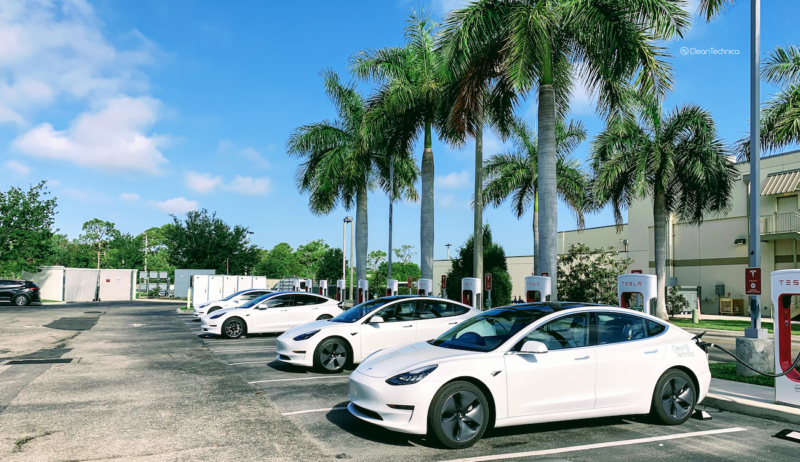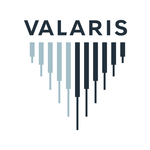
Yesterday, we heard from Electrify America about a cool new project that just went online: a solar power plant that puts enough renewable energy into the grid to more than make up for its EV charging sessions.
Details On The Deal
Electrify America has commenced commercial operation of the new 75 MW Electrify America Solar Glow™ 1 solar photovoltaic renewable energy generation project in San Bernardino County, California. This project, which was announced last year, is the outcome of a 15-year virtual power purchase agreement (VPPA) with developer Terra-Gen.
Electrify America, who says it’s the largest open network of DC fast chargers for electric vehicles in the U.S., has recently entered into a virtual power purchase agreement for new renewable energy generation. This new construction adds to the existing renewable energy sources out there, providing additional energy that may not be readily accessible otherwise.
“Electrify America Solar Glow™ 1 is an important milestone in our commitment to reduce our energy carbon footprint,” said Robert Barrosa, President and CEO of Electrify America. “Electrify America is committed to being a part of the broader charging solution for EV drivers today and in the future.”
This investment is projected to generate 75 MW of solar power at peak capacity, equivalent to the energy consumed by 500 EVs charging simultaneously at an average speed of 150 kilowatts. The total annual production is estimated to be 225 gigawatt-hours (GWh). In 2022, Electrify America says it facilitated over 5 million customer charging sessions, which is 3.5 times the number of sessions in 2021. These sessions resulted in approximately 173 GWh of electricity, enabling an estimated 493 million miles of electric driving and avoiding the consumption of around 21 million gallons of gasoline.
In other words, this deal is going to put more renewable energy into the national grid than Electrify America consumes for its charging sessions, effectively offsetting its usage.
“We expect the demand on our charging network to continue to rise with the increase in EV ownership,” said Jigar Shah, Director of Energy Services at Electrify America. “Solar Glow™ 1 adds new additional 100% renewable energy generation with estimated annual production that exceeds our 2022 network usage.”
I asked Electrify America’s rep about future demand and future Solar Glow facilities, and the company said it doesn’t have any announcements to make. But, it seems obvious that putting the number 1 after the name indicates that a 2, 3, and 4 are probably at least hoped for.
“This solar project is a significant accomplishment reinforcing our commitment in 2022 to back all energy delivered to customers on Electrify America’s coast-to-coast public, ultra-fast DC charging network with 100% renewable energy,” Barrosa said.
The Electrify America Solar Glow™ 1 project includes 200,000+ solar panels. It spans over a square mile.
What’s A Virtual Power Purchase Agreement?
A Power Purchase Agreement (PPA) is a legal contract between an electricity generator and a buyer, typically a utility company or a corporate entity. It outlines the terms and conditions under which the generator will sell electricity to the buyer over a specified period of time, usually long-term agreements ranging from 10 to 25 years.
In a PPA, the generator agrees to provide a certain amount of electricity, often from renewable sources such as wind or solar, at an agreed-upon price. The buyer commits to purchasing this electricity at the specified price for the duration of the agreement. This allows the generator to secure a stable revenue stream and helps the buyer meet its energy needs with a fixed, predictable cost.
PPAs are commonly used in the renewable energy industry as a means to finance and develop new renewable energy projects. They provide a way for generators to secure long-term contracts, which can help attract investment and ensure the economic viability of renewable energy projects.
PPA projects are typically on the property of the buyer, and it’s then up to the buyer to use or sell the energy themselves. For example, the purchaser of a PPA on a residential roof will use the energy inside their own home and sell the remaining power to the local grid, just like they would if they owned the solar panels themselves.
In a Virtual Power Purchase Agreement, more of the arrangement is handled by the owner of the system. In the case of Electrify America’s Solar Glow 1, Terra-Gen not only produces, but also sells, the energy on Electrify America’s behalf. When the electricity price is above what Electrify America agreed on, they get whatever money is left. When electricity sells for less than Electrify America pays, they have to cover the difference.
How This Helps Electrify America
The obvious big thing is that it helps reduce the environmental impact of charging at an Electrify America station. Its customers don’t use the solar energy directly in most cases, but other areas are using less fossil fuels. This makes charging at their stations (when working well) more attractive to EV drivers, who generally tend to care about environmental impacts.
Doing this also helps not only Electrify America, but the parent company VW to help improve their public image. Not only is there some bad history there, with Electrify America basically being VW’s punishment for the Dieselgate scandal, but they’re also struggling with charging reliability at their older stations.
They can get both of these big benefits without having to own and manage their own solar power plants. While I’m sure Electrify America’s staff knows a lot about the electricity market, they probably don’t have the expertise on staff for solar power plants specifically. Outsourcing their renewable energy purchases helps them stick to their core mission, which definitely needs a lot of attention right now.
It’s also a great financial arrangement for Electrify America. When prices are high, and it costs more to provide charging to customers, the solar plant will often also be bringing in a profit that helps the company level off its own expenses. When prices are low, and the company can turn more of a profit from charging, it’s easier for them to absorb the hit from any losses under the VPPA.
This doesn’t solve all of the company’s problems, but it does help them in these key ways so they can move forward.
Featured image provided by Electrify America.
I don’t like paywalls. You don’t like paywalls. Who likes paywalls? Here at CleanTechnica, we implemented a limited paywall for a while, but it always felt wrong — and it was always tough to decide what we should put behind there. In theory, your most exclusive and best content goes behind a paywall. But then fewer people read it! We just don’t like paywalls, and so we’ve decided to ditch ours. Unfortunately, the media business is still a tough, cut-throat business with tiny margins. It’s a never-ending Olympic challenge to stay above water or even perhaps — gasp — grow. So …




